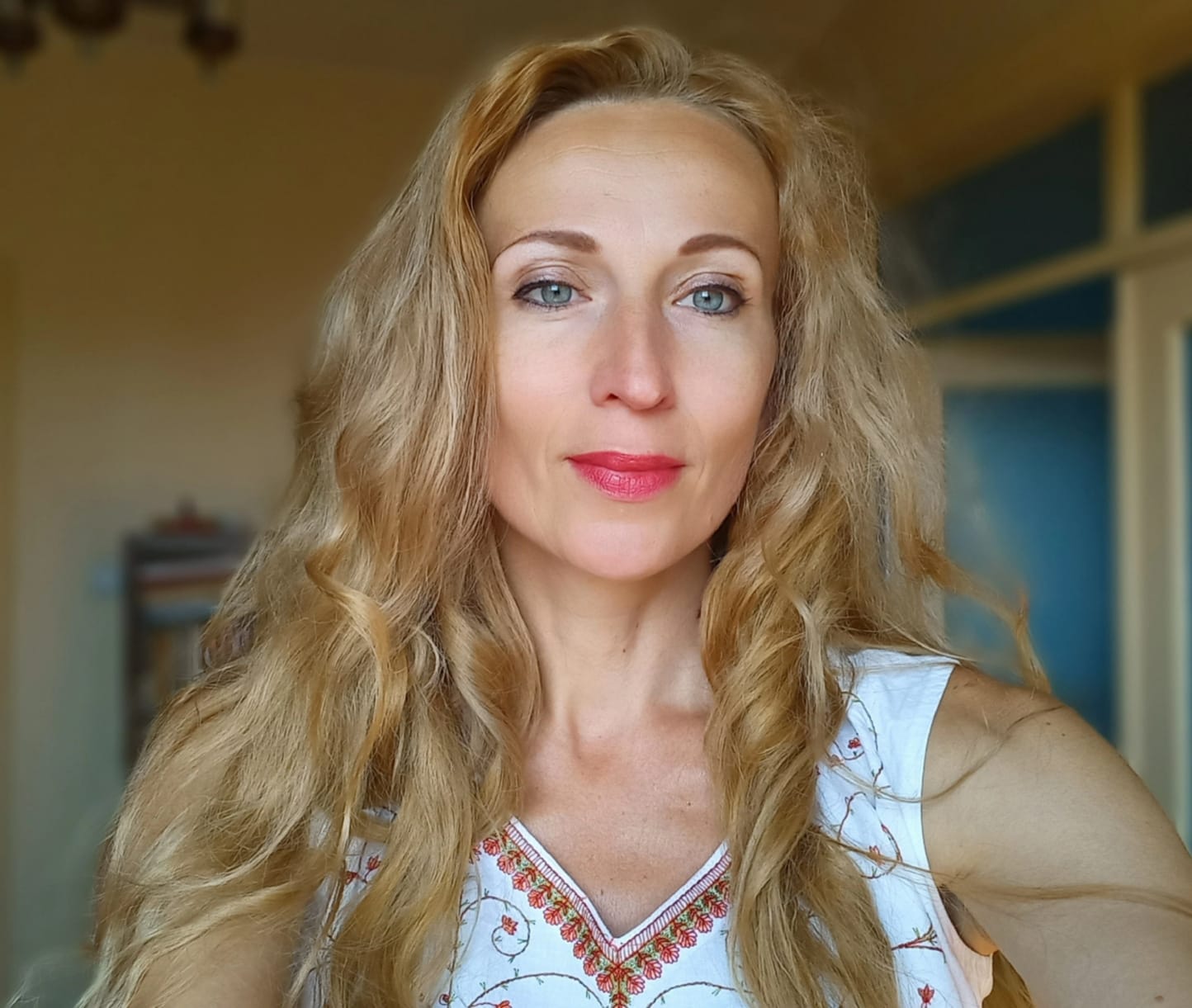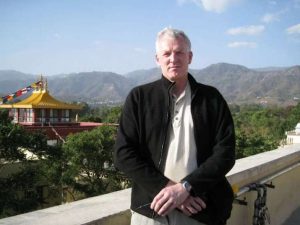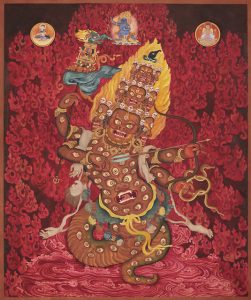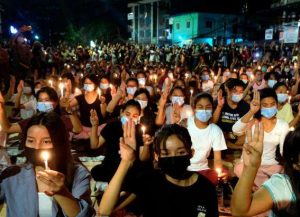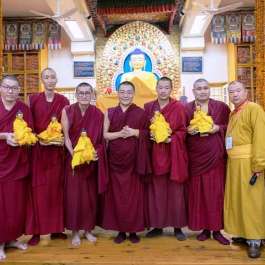
“Bendy Buddhist” is how Ellen Johannesen jokingly describes herself. And “bendy Buddhism” is a wonderful metaphor for the intersection between Buddhism and yoga.
Ellen was born in Norway and has been a yoga teacher for more than 20 years. She encountered Ashtanga yoga in 1994 and has practiced ever since. In 2002, Ellen cofounded the first Ashtanga studio in Oslo, Ashtanga Yoga Oslo, where she was the principal teacher in charge of the Mysore program.
Ellen’s interest in Buddhism brought her first to Bylakuppe, South India, where she spent three years living in a Tibetan monastery. She then moved to Kathmandu, where, after completing a Tibetan translator training course, she earned a master’s degree in Buddhist Studies and Himalayan Languages from Kathmandu University.
BDG had the privilege of interviewing Ellen and talking about her experiences with Buddhism and yoga.

BDG: Where is the intersection between Ashtanga yoga and the Buddhist path in your personal practice?
Ellen Johannsen: I have worked with the body my whole life: I’ve been an Ashtanga practitioner for more than 27 years and before that I was a professional dancer. At first, this work was about discipline. I didn’t dance or practice yoga because I loved it but because I needed some sense of centering and alignment in what was to me a chaotic world.
I went from rather harsh, authoritarian ballet/modern dance training in London to studying more conceptual and somatic dance techniques in the Netherlands. This latter approach is concerned with accessing the body without enforcing aesthetic patterns. You want to work with the forces that move the body: gravity, lightness, speed, and momentum. It often took the form of dance improvisation, which is a bit like high-speed meditation: you have to not only sense inwardly, but also make choices as to when to react and move with impulses, and when not to. In this way, it teaches your mind to separate awareness and content.
Since movement was my way into awareness, I initially rejected Buddhism as a method. I thought, like many people do, that Buddhism was all about sitting still in meditation, while yoga was all about moving.
Then, one year I met an American Buddhist nun in Mysore and I started to study the Diamond Cutter Sutra with her. I immediately felt that it aligned so well with how I perceived the world. Moreover, Buddhism has so many practical methods to offer: it seems to work on the heart and the emotions, offering very direct paths to cutting through our habitual preferences and dislikes. I loved that Buddhism was so “radical”—almost like an artistic endeavor: to hold a world view in which you acted out of altruism, and not egoism, was really like swimming upstream and acting against the norm.
This inspired me to go and live in Namdroling* monastery for three years. This meant experiencing what life might be like when a whole group of people live according to the view of Buddhism and choose to engage with its practices. The most memorable experience, I thought, was that of the passing of the abbot of the monastery, Penor Rinpoche.** For almost a week he sat in deep meditation, without any physical vital signs. There was an amazing atmosphere pervading the entire monastery.
After I took up the academic study of Buddhism I started to wonder why Buddhism and yoga were traditionally regarded as separate traditions when clearly they had so much in common: yoga in the sense of the philosophical darshana, which holds Patanjali’s Yoga Sutras (fifth century) as its foundational text, is concerned with methods for training the mind. It has many borrowings (or shared notions) from Buddhism’s Abhidharma from the same era, speaking about dhyana (meditation), and various stages of realization. The hallmark of both systems is that insight comes as direct perception through the cultivation of our senses.
Yoga in the sense of Hatha yoga/tantra (eighth century onwards) takes the body into account, using the winds and channels of the subtle body to transcend mundane experience. This is widely practiced within tantric Buddhism as we find in the Tibetan tradition.
The techniques of Patanjali’s yoga and Hatha yoga are both shared between Buddhist and the Hindu traditions. One scholar has described “yoga” as a “free software” that has been shared between many traditions: Buddhist, Brahmanical, Muslim, and Jain. The difference lies in how and for what purpose these schools engage in the practices. Within Buddhism it was done with the intention to free all beings from suffering. There can be no Buddhist tantric practice without bodhicitta*** as a foundation.

BDG: Which Buddhist teachers have had the strongest influence on your spiritual path?
EJ: The Buddhist teachers I feel most closely connected to are those who emphasize the subtle body and also dare to be critical of their own tradition: Dhammadipa, who is a lifelong practitioner of several Buddhist paths—Theravada, Yogacara, and Zen—also stresses the importance of cultivating body awareness, admitting that excessive sitting harmed his body. He therefore teaches qi gong and yoga during his retreats. For me, he represents a key to understanding several traditions, but also going beyond them. My other teacher is Dolpo Tulku Rinpoche, who although a brilliant scholar, takes great interest in Indian Hatha yoga and pranayama, which he also teaches in his retreats. I have recently connected with scholar-practitioner Ian Baker, who is also a faculty member on my in-depth course. His great contribution to my course is his ability to cut through the cultural and hierarchical scaffolding of Tibetan Buddhist practices, which can make them seem alien to us, and present them as effective means to transform our bodies and minds.

BDG: Can you talk a little about your in-depth course and the place of Buddhist practice within it?
EJ: In my two-year in-depth course, I attempt to “mend the gap” between Buddhism and yoga. I think it’s time to see yoga in a wider sense as a transnational ever-evolving tradition. More yoga teachers than me these days include Buddhist practices in their teaching because they have proven to be effective and beneficial. One of the foundational practices in my course is sustainable compassion meditation. In this practice we build a basis for meditation by seeing ourselves as relational beings surrounded by our network of care and support (friends, family, pets, mentors, and so on). This visualization calms the nervous system, allows us to be at home in our bodies and at ease with our minds, before we attempt to “meditate.”

BDG: What is the most important message that you want to convey to your students?
EJ: What I want my students to understand is that we become what we are through processes, consciously or unconsciously. Mostly we develop unconscious patterns through cultural and social conditioning. Yoga is precisely the path to overcome this conditioning, mentally and physically: it teaches you to steer your process of becoming toward the most optimal purpose. For this we need a deep understanding of the potential of our body-minds and the practices with which to actualize them!
* Namdroling Nyingmapa Monastery (Thegchog Namdrol Shedrub Dargye Ling) is the largest teaching center of the Nyingma lineage of Tibetan Buddhism in the world. It is located in Bylakuppe, Mysuru District, in the Indian state of Karnataka.
** Kyabjé Drubwang Padma Norbu Rinpoche (1932–2009), was the 11th throne-holder of the Palyul Lineage of the Nyingma school.
*** In Mahayana Buddhism, bodhicitta (Skt. awakening mind) is the compassionate aspiration to attain enlightenment for the benefit of all sentient beings, and the quality of a bodhisattva.
Related features from BDG
Book Review: Tatiana Elle’s Yoga for Women: 45 Poses for Physical, Emotional & Spiritual Well-being
Tibetan Yoga, the Hidden Treasure of Tibetan Buddhism: An Interview with Ian A. Baker
Demystifying the Yoga of Bliss: An Interview with Dr. Nida Chenagtsang, Part One


